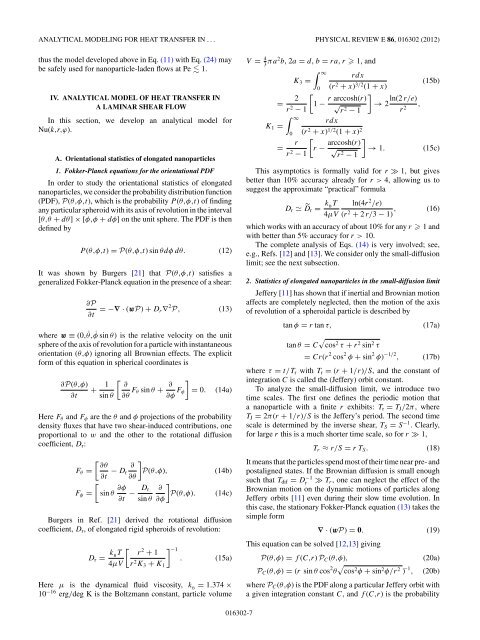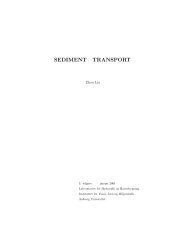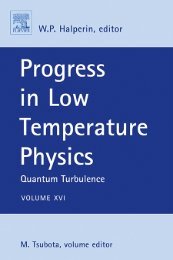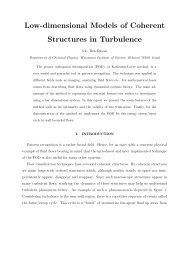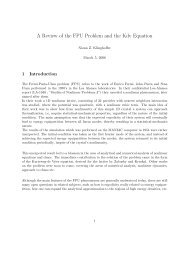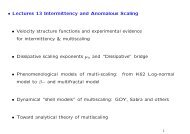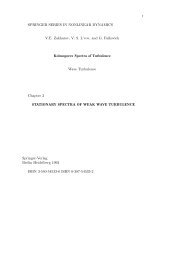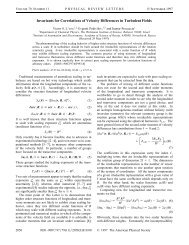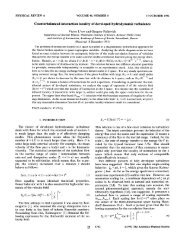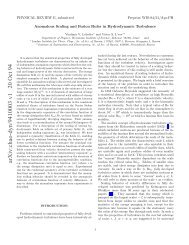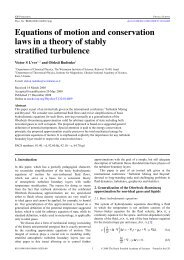Analytical modeling for heat transfer in sheared flows of nanofluids
Analytical modeling for heat transfer in sheared flows of nanofluids
Analytical modeling for heat transfer in sheared flows of nanofluids
You also want an ePaper? Increase the reach of your titles
YUMPU automatically turns print PDFs into web optimized ePapers that Google loves.
ANALYTICAL MODELING FOR HEAT TRANSFER IN ... PHYSICAL REVIEW E 86, 016302 (2012)<br />
thus the model developed above <strong>in</strong> Eq. (11) with Eq. (24) may<br />
be safely used <strong>for</strong> nanoparticle-laden <strong>flows</strong> at Pe 1.<br />
IV. ANALYTICAL MODEL OF HEAT TRANSFER IN<br />
A LAMINAR SHEAR FLOW<br />
In this section, we develop an analytical model <strong>for</strong><br />
Nu(k,r,ϕ).<br />
A. Orientational statistics <strong>of</strong> elongated nanoparticles<br />
1. Fokker-Planck equations <strong>for</strong> the orientational PDF<br />
In order to study the orientational statistics <strong>of</strong> elongated<br />
nanoparticles, we consider the probability distribution function<br />
(PDF), P(θ,φ,t), which is the probability P (θ,φ,t) <strong>of</strong> f<strong>in</strong>d<strong>in</strong>g<br />
any particular spheroid with its axis <strong>of</strong> revolution <strong>in</strong> the <strong>in</strong>terval<br />
[θ,θ + dθ] × [φ,φ + dφ] on the unit sphere. The PDF is then<br />
def<strong>in</strong>ed by<br />
P (θ,φ,t) = P(θ,φ,t)s<strong>in</strong>θdφdθ. (12)<br />
It was shown by Burgers [21] that P(θ,φ,t) satisfies a<br />
generalized Fokker-Planck equation <strong>in</strong> the presence <strong>of</strong> a shear:<br />
∂P<br />
∂t =−∇ · (wP) + Dr∇ 2 P, (13)<br />
where w ≡ (0, ˙θ,˙φ s<strong>in</strong> θ) is the relative velocity on the unit<br />
sphere <strong>of</strong> the axis <strong>of</strong> revolution <strong>for</strong> a particle with <strong>in</strong>stantaneous<br />
orientation (θ,φ) ignor<strong>in</strong>g all Brownian effects. The explicit<br />
<strong>for</strong>m <strong>of</strong> this equation <strong>in</strong> spherical coord<strong>in</strong>ates is<br />
∂P(θ,φ)<br />
∂t<br />
+ 1<br />
<br />
∂<br />
s<strong>in</strong> θ ∂θ Fθ s<strong>in</strong> θ + ∂<br />
∂φ Fφ<br />
<br />
= 0. (14a)<br />
Here Fθ and Fφ are the θ and φ projections <strong>of</strong> the probability<br />
density fluxes that have two shear-<strong>in</strong>duced contributions, one<br />
proportional to w and the other to the rotational diffusion<br />
coefficient, Dr:<br />
Fθ =<br />
Fφ =<br />
<br />
∂θ ∂<br />
− Dr P(θ,φ), (14b)<br />
∂t ∂θ<br />
<br />
s<strong>in</strong> θ ∂φ<br />
<br />
Dr ∂<br />
− P(θ,φ). (14c)<br />
∂t s<strong>in</strong> θ ∂φ<br />
Burgers <strong>in</strong> Ref. [21] derived the rotational diffusion<br />
coefficient, Dr, <strong>of</strong> elongated rigid spheroids <strong>of</strong> revolution:<br />
Dr = kBT 2 r + 1<br />
4μV r2 −1 . (15a)<br />
K3 + K1<br />
Here μ is the dynamical fluid viscosity, k B = 1.374 ×<br />
10 −16 erg/deg K is the Boltzmann constant, particle volume<br />
016302-7<br />
V = 4<br />
3πa2b,2a = d, b = ra, r 1, and<br />
∞ rdx<br />
K3 =<br />
0 (r2 + x) 3/2 (15b)<br />
(1 + x)<br />
= 2<br />
r2 <br />
<br />
r arccosh(r) ln(2 r/e)<br />
1 − √ → 2<br />
− 1 r2 − 1 r2 ,<br />
∞ rdx<br />
K1 =<br />
0 (r2 + x) 1/2 (1 + x) 2<br />
= r<br />
r2 <br />
r −<br />
− 1<br />
arccosh(r)<br />
<br />
√ → 1. (15c)<br />
r2 − 1<br />
This asymptotics is <strong>for</strong>mally valid <strong>for</strong> r ≫ 1, but gives<br />
better than 10% accuracy already <strong>for</strong> r>4, allow<strong>in</strong>g us to<br />
suggest the approximate “practical” <strong>for</strong>mula<br />
Dr Dr = k B T<br />
4μV<br />
ln(4r2 /e)<br />
(r2 , (16)<br />
+ 2 r/3 − 1)<br />
which works with an accuracy <strong>of</strong> about 10% <strong>for</strong> any r 1 and<br />
with better than 5% accuracy <strong>for</strong> r>10.<br />
The complete analysis <strong>of</strong> Eqs. (14) is very <strong>in</strong>volved; see,<br />
e.g., Refs. [12] and [13]. We consider only the small-diffusion<br />
limit; see the next subsection.<br />
2. Statistics <strong>of</strong> elongated nanoparticles <strong>in</strong> the small-diffusion limit<br />
Jeffery [11] has shown that if <strong>in</strong>ertial and Brownian motion<br />
affects are completely neglected, then the motion <strong>of</strong> the axis<br />
<strong>of</strong> revolution <strong>of</strong> a spheroidal particle is described by<br />
tan φ = r tan τ, (17a)<br />
tan θ = C cos2 τ + r2 s<strong>in</strong>2 τ<br />
= Cr(r 2 cos 2 φ + s<strong>in</strong> 2 φ) −1/2 , (17b)<br />
where τ = t/Tr with Tr = (r + 1/r)/S, and the constant <strong>of</strong><br />
<strong>in</strong>tegration C is called the (Jeffery) orbit constant.<br />
To analyze the small-diffusion limit, we <strong>in</strong>troduce two<br />
time scales. The first one def<strong>in</strong>es the periodic motion that<br />
a nanoparticle with a f<strong>in</strong>ite r exhibits: Tr = TJ/2π, where<br />
TJ = 2π(r + 1/r)/S is the Jeffery’s period. The second time<br />
scale is determ<strong>in</strong>ed by the <strong>in</strong>verse shear, TS = S−1 . Clearly,<br />
<strong>for</strong> large r this is a much shorter time scale, so <strong>for</strong> r ≫ 1,<br />
Tr ≈ r/S = rTS. (18)<br />
It means that the particles spend most <strong>of</strong> their time near pre- and<br />
postaligned states. If the Brownian diffusion is small enough<br />
such that Tdif = D−1 r ≫ Tr, one can neglect the effect <strong>of</strong> the<br />
Brownian motion on the dynamic motions <strong>of</strong> particles along<br />
Jeffery orbits [11] even dur<strong>in</strong>g their slow time evolution. In<br />
this case, the stationary Fokker-Planck equation (13) takes the<br />
simple <strong>for</strong>m<br />
∇ · (wP) = 0. (19)<br />
This equation can be solved [12,13] giv<strong>in</strong>g<br />
P(θ,φ) = f (C,r) PC(θ,φ), (20a)<br />
PC(θ,φ) = (r s<strong>in</strong> θ cos 2 θ cos2φ + s<strong>in</strong>2φ/r2 ) −1 , (20b)<br />
where PC(θ,φ) is the PDF along a particular Jeffery orbit with<br />
a given <strong>in</strong>tegration constant C, and f (C,r) is the probability


